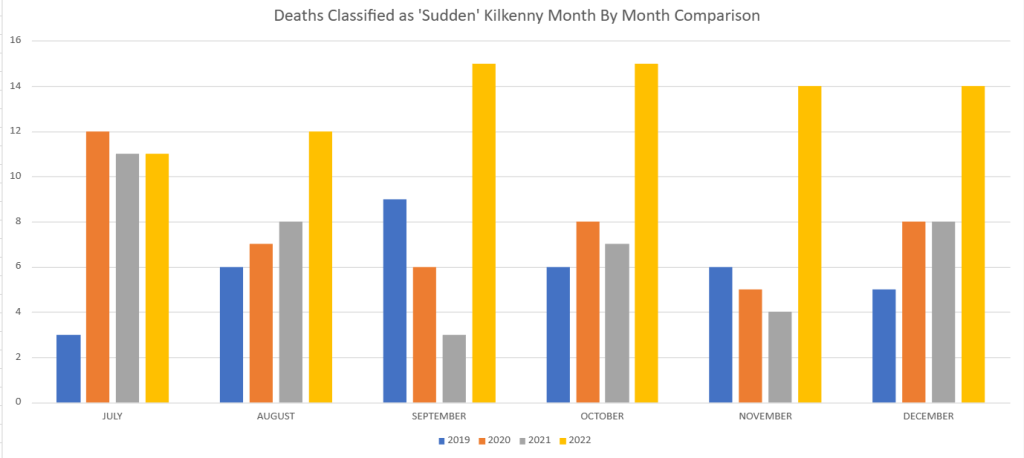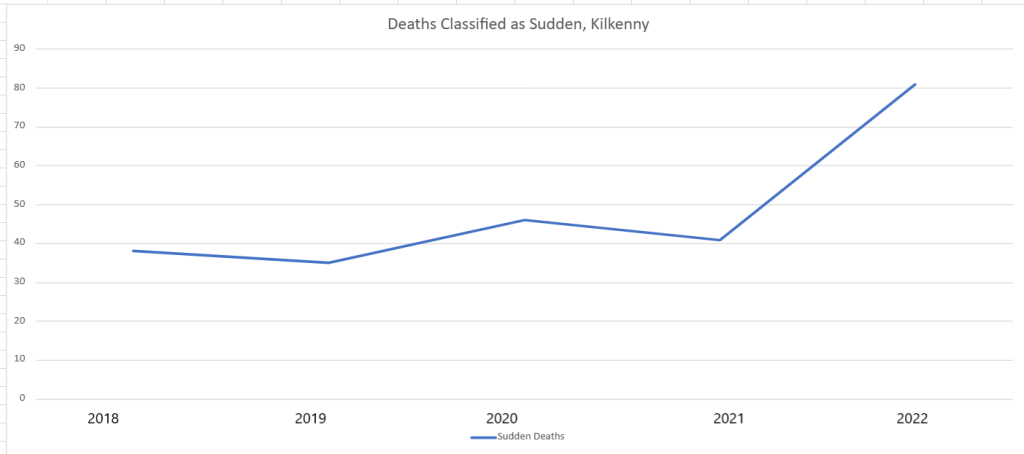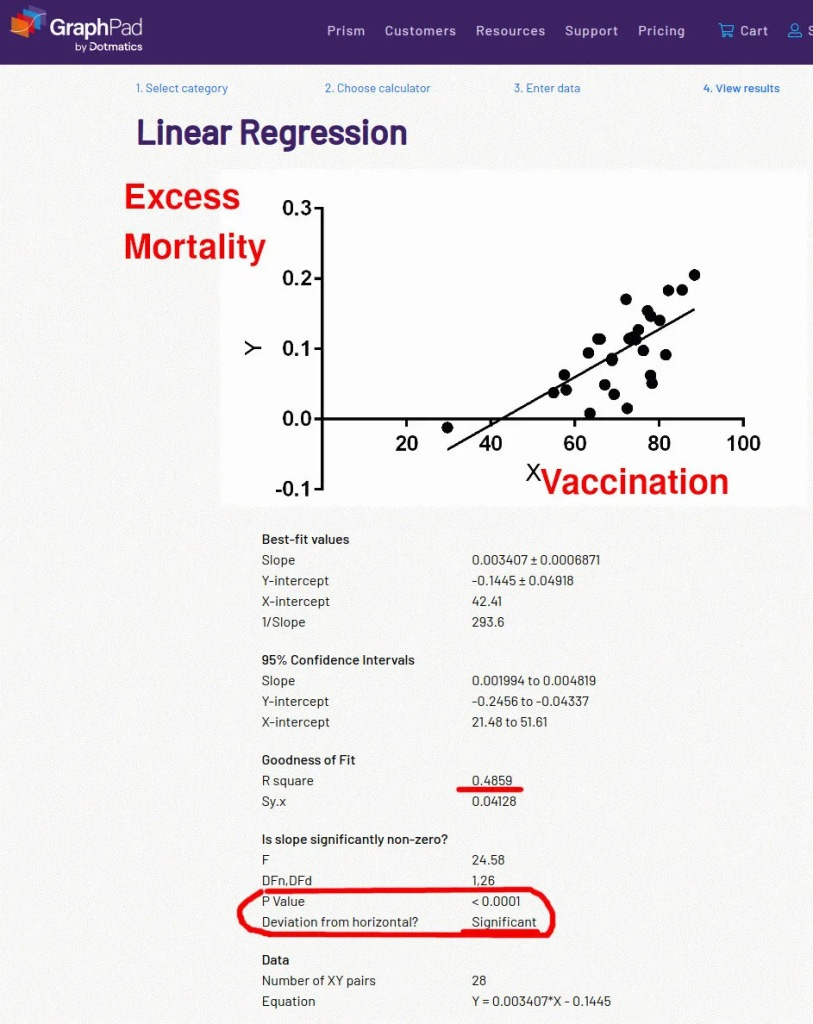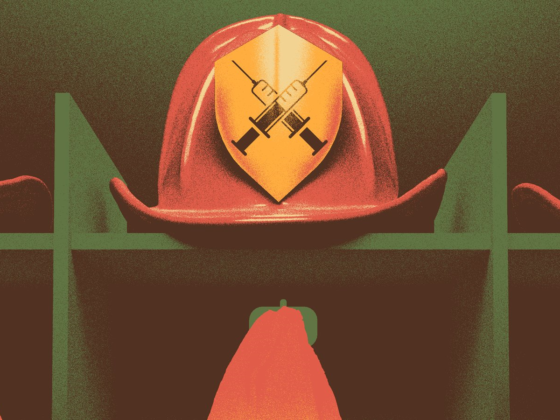Introduction
A dataset of deaths and sudden deaths provided by Patrick E. Walsh from Kilkenny, Ireland has been under-utilised by researchers investigating the surge in sudden death. However, this is a very useful dataset for researchers to examine to demonstrate a significant rise in all-cause mortality, as well as deaths classified as ‘sudden’ in a small region of Ireland. I have written this article to draw more attention to this dataset, as I have personally not seen it reported among the staples of statistical analysis in the Covid-19 ‘vaccine’ sceptic space.
What is the Kilkenny Dataset?
Recently, in response to British Parliamentarian Andrew Bridgen (who has recently become a fierce critic of the Covid-19 ‘vaccine’ in Parliament, demanding that the jabs be stopped) twitter user @_Richard_JG posted an extremely valuable article from Kilkenny, Ireland.
(The source for the 89.9% ‘vaccination’ rate in Kilkenny is here. As an aside, that makes it a relatively low ‘vaccine’ uptake in comparison with other counties in Ireland!)
The article itself states:
A CONCERNED local man has emailed a group of what he terms ‘people who hold positions of influence and trust in Kilkenny’, bringing to their attention what he describes as important facts on deaths in Kilkenny, particularly sudden deaths.
Patrick Walsh has gone through the RIP.IE obituaries, to find both deaths and deaths which he classifies as ‘sudden’. He determined a sudden death by the criteria below:
Any explicit accidents or suicides are not included in ‘Suddenlys’.‘Suddenlys’ are identified by narrative or in condolences.
A similar thing that we would do when identifying sudden deaths for the In Memoriam project for Mark Crispin Miller, essentially.
The Total Death Data
This follow up article contains data from Kilkenny for 6 months of the year, July to December, and compares 2018 to 2022. I have produced some graphs showing this data below.
The below chart shows the deaths by month for 2019-2022. (I excluded 2018 so the graph didn’t get too messy).

Here is the same data, in a different format, with each month rather than each year:

Here is the total deaths for the 6 month period, plotted on a chart, 2018-2022:

The Sudden Death Data
Here are the equivalent data for the sudden deaths only, as defined above.

The same data by month:

Graph Plot:

What’s Valuable About This Data?
The fact that all the obituaries are publicly posted on RIP.IE and can be searched by any individuals who are willing to do so. The critics of this kind of approach may say the data is fabricated, but this is very unlikely given that anyone can check it. For example, I checked the number of deaths for December 2022 and got the same amount as Walsh (128). As for sudden deaths, there are 11 obituaries that use the term ‘suddenly’ or ‘unexpectedly’, and several more that use the term ‘after a short/brief illness’ which can also sometimes be a code for ‘vaccine’ death. So 3 more cases from these or from comments left on the obituaries (which I did not check) means the 14 number given is reasonable, possibly slightly conservative.
This data is also good as it isn’t subject to too many biases. The deaths classified as sudden are done so in the obituaries themselves or condolences, which means they are not subject to the bias of the ‘vaccine’ sceptic who may possibly be over-eager (or be accused of being over-eager) to blame deaths on the ‘vaccine’. And it would be impossible to game obituary notices, after all, someone is either deceased or not. It is also valuable as it has a control group of ‘non-sudden deaths’ for comparison, that allows us to figure out if there is a comparative increase in death classified as ‘sudden’.
Breaking Down the Data
The graphs above clearly demonstrate that for 2022, both deaths and sudden deaths are showing a significant increase. Although there is a spike in death for November and December 2022, it is not possible to conclude from this that the number of deaths will continue to increase as this could be a seasonal spike.
I calculated the percentages of deaths for each month classified as sudden, and plotted them on a graph, seen below. As the sample size for each month is not that large (lowest = 55, highest = 128), caution is advised on that basis. Nevertheless, we see in increase in the percentage of deaths classified as sudden in 2022:

This is despite the fact that overall deaths also increased in 2022!
What is most striking about this data is there is no evidence of an increase in sudden deaths in 2021. This supports the integrity of the research itself, as anyone simply looking to manufacture data to vilify the ‘vaccine’ would start their ‘sudden death’ counting in mid-2021. This suggests that while some young and healthy people are dying immediately from the ‘vaccine’ (not shown by this data, but it is present in other datasets), significantly more relatively young and healthy people are ‘dying suddenly’ a long time after initial ‘vaccination’ (either because a booster tips the ‘vaccine’ damage calculus to fatal, or because of damage sustained by previous ‘vaccination’ doses does not immediately result in death).
That the sudden death problem is increasing is supported by evidence from the Mark Crispin Miller reports, as well as statistical analysis from sources such as Igor Chudov, who reports that the correlation between excess deaths and ‘vaccination’ rates is strengthening:

The linear regression above shows that the vaccination rate explains 49% of excess mortality and that the relationship is highly statistically significant (P < 0.0001 is extremely significant).
What is worse, compared to a similar analysis two months before, the relationship has gotten STRONGER in terms of explanatory power (R squared), as well as steepness of the slope.
IGOR CHUDOV (CHUDOV’S GRAPH ABOVE).
This can be plausibly explained by at least three mechanisms. The first of these is the ‘subclinical myocarditis theory‘ put forward by Dr. Peter McCullough. McCullough argues that the spike proteins that are produced after an mRNA shot damage the heart in ways that may not be immediately obvious (e.g. the individual does not experience typical symptoms like chest pain). The heart damage in the presence of adrenaline (when playing sport, or when waking up) then tips the individual over the edge into cardiac arrest and sudden death. The second of these is ‘turbo cancer’, where the immune system’s ability to fight cancer is compromised, leading to rapid diagnosis of stage 4 cancer and death. The third mechanism is Ig4 immune tolerance to spike protein, which causes sudden death as it allows the spike to run rampant in the body, and the immune system does not fight the disease when exposed to Sars-Cov-2. This leads to a mild illness followed by sudden death.
How does this fit in with data showing a large number of deaths for 2021 from the ‘vaccine’, for example, VAERS? There are more overall deaths in 2021 than 2019, those deaths were simply no more likely to be classified as ‘sudden’. It’s likely some of this excess is ‘vaccine’ induced (as demonstrated by other sources), it is just not considered ‘sudden’ by the obituary writers. There may be multiple reasons for this, perhaps middle-aged and older people died more often early on from the ‘vaccine’ and their deaths were not considered ‘sudden’, while young people weathered initial ‘vaccine’ damage better, only to ‘die suddenly’ in 2022. Perhaps it is the booster – rather than dose one and two – that is the critical trigger for sudden death in a large number of cases, with the late 2021/early 2022 booster campaign proving the fatal factor.
Conclusion
Data from obituary analysis from Kilkenny, Ireland, shows a significant increase in sudden death for 2022 as opposed to previous years. This supports other sources of data that we have a significant sudden death problem in heavily ‘vaccinated’ countries. Patrick Walsh deserves credit for compiling this dataset for Kilkenny that provides yet another arrow in the bow of the ‘vaccine’ sceptic.














